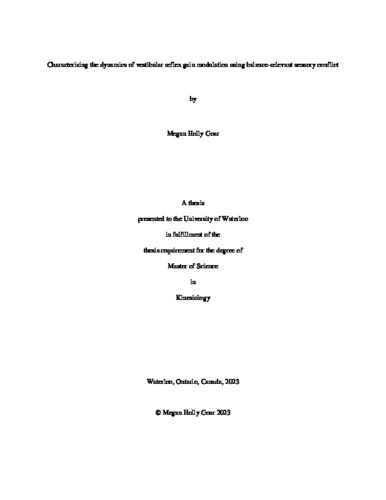| dc.description.abstract | Electrical vestibular stimulation (EVS) can be used to evoke reflexive body sways as a probe of vestibular control of balance. However, EVS introduces sensory conflict by decoupling vestibular input from actual body motion, prompting the central nervous system (CNS) to potentially perceive vestibular signals as less reliable. In contrast, light touch reduces sway by providing reliable feedback about body motion and spatial orientation. The juxtaposition of reliable and unreliable sensory cues enables exploration of multisensory integration during balance control. I hypothesized that when light touch is available, coherence and gain between EVS input and center of pressure (CoP) output would decrease as the CNS reduces the weighting of vestibular cues. Additionally, I hypothesized that the CNS would require less than 0.5 seconds to adjust weighting of sensory cues upon introduction or removal of light touch. In two experiments, participants stood as still as possible while receiving continuous stochastic EVS (with a frequency of 0-25 Hz, amplitude of ± 4 mA, and a duration of 200-300 seconds), while either: lightly touching a load cell (<2 N); holding their hand above a load cell; or intermittently switching between touching and not touching the load cell. Anterior-posterior (AP) CoP and linear accelerations from body-worn accelerometers were collected to calculate the root mean square (RMS) of AP CoP, as well as the coherence and gain between EVS input and AP CoP or acceleration outputs. Light touch led to a decrease in CoP RMS (mean 49% decrease) with and without EVS. Significant coherence between EVS and AP CoP was observed between 0.5 Hz and 24 Hz in the NO TOUCH condition, and between 0.5 Hz and 30 Hz in the TOUCH condition, with TOUCH having significantly greater coherence from 11 to 30 Hz. Opposite to coherence, EVS-AP CoP gain decreased in the TOUCH condition between 0.5-8 Hz (mean decrease 63%). Among the available acceleration data, only the head exhibited a significant increase in coherence above 10 Hz in the TOUCH condition, compared to the NO TOUCH condition. Light touch reduced CoP displacement, but increased variation in the CoP signal that can be explained by EVS input. Light touch may cause the CNS to attribute EVS signals to head movements and therefore up-weight vestibulocollic responses while downweighting vestibulospinal balance responses. Changes in coherence and gain started before the transition to the NO TOUCH condition and after the transition to the TOUCH condition. The loss of sensory information may be more destabilizing than addition, necessitating anticipatory adjustments. These findings demonstrate the ability of one sensory modality to modulate the utilization of another by the CNS, and highlight asymmetries in the timing of responses to the introduction and removal of sensory information, which may impact behavior. | en |

